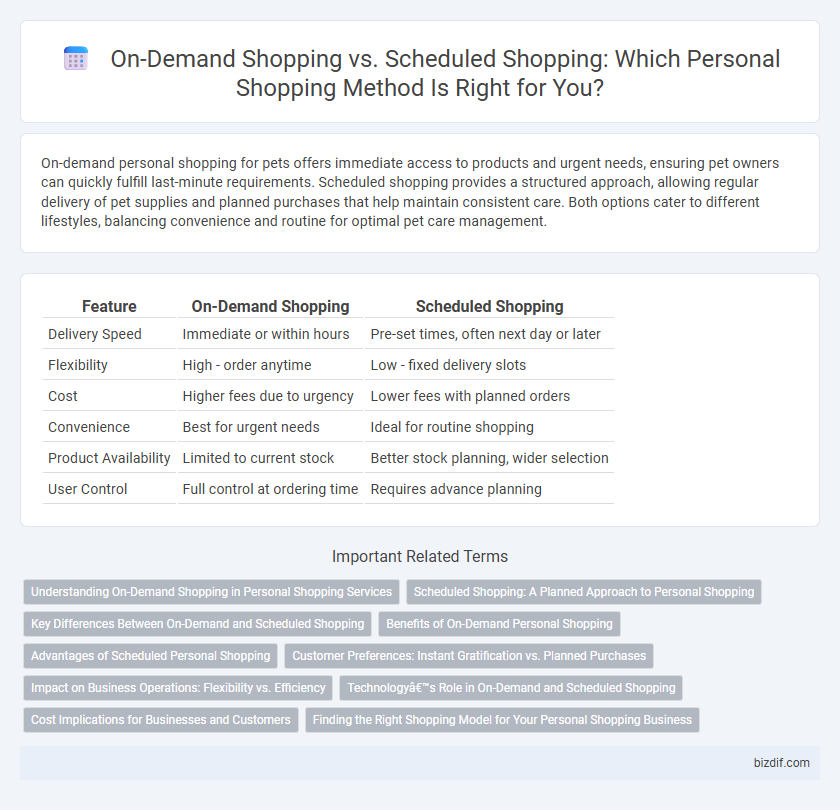On-demand personal shopping for pets offers immediate access to products and urgent needs, ensuring pet owners can quickly fulfill last-minute requirements. Scheduled shopping provides a structured approach, allowing regular delivery of pet supplies and planned purchases that help maintain consistent care. Both options cater to different lifestyles, balancing convenience and routine for optimal pet care management.
Table of Comparison
| Feature | On-Demand Shopping | Scheduled Shopping |
|---|---|---|
| Delivery Speed | Immediate or within hours | Pre-set times, often next day or later |
| Flexibility | High - order anytime | Low - fixed delivery slots |
| Cost | Higher fees due to urgency | Lower fees with planned orders |
| Convenience | Best for urgent needs | Ideal for routine shopping |
| Product Availability | Limited to current stock | Better stock planning, wider selection |
| User Control | Full control at ordering time | Requires advance planning |
Understanding On-Demand Shopping in Personal Shopping Services
On-demand shopping in personal shopping services offers immediate access to products, allowing customers to place orders and receive items quickly without waiting for a predetermined schedule. This service leverages real-time inventory updates and flexible delivery options to meet urgent needs and enhance convenience. Efficient on-demand shopping platforms use AI and data analytics to predict preferences, ensuring personalized selections delivered promptly.
Scheduled Shopping: A Planned Approach to Personal Shopping
Scheduled shopping offers a strategic and organized method for personal shopping, ensuring all needs are addressed systematically without last-minute rushes. This approach reduces impulse purchases and maximizes budget efficiency by adhering to a pre-set list and timeline. Consumers experience enhanced convenience and time management, as shopping trips or deliveries are planned to fit perfectly within their routine.
Key Differences Between On-Demand and Scheduled Shopping
On-demand shopping offers immediate product availability and delivery, ideal for urgent needs, while scheduled shopping allows consumers to select specific times for order placement and delivery, enhancing convenience and planning. On-demand services prioritize speed and flexibility, leveraging real-time inventory tracking, whereas scheduled shopping emphasizes predictability and often supports bulk or planned purchases with optimized logistics. Key differences center around timing preferences, delivery speed, and the user's need for spontaneity versus structured shopping routines.
Benefits of On-Demand Personal Shopping
On-demand personal shopping offers immediate access to products and services, ensuring customers receive items exactly when needed without waiting for preset delivery times. This flexibility enhances convenience by allowing shoppers to respond instantly to changing preferences or urgent requirements. Real-time assistance from personal shoppers also improves the overall experience through tailored recommendations and faster problem resolution.
Advantages of Scheduled Personal Shopping
Scheduled personal shopping offers the advantage of tailored, uninterrupted attention from professional shoppers who prioritize customer preferences and create a curated shopping experience. This method enhances convenience by allowing clients to plan purchases ahead, ensuring availability of desired items and reducing impulse buys. Furthermore, scheduled sessions improve time management and provide opportunities for detailed consultation, resulting in a more satisfying and efficient shopping process.
Customer Preferences: Instant Gratification vs. Planned Purchases
On-demand shopping caters to customers seeking instant gratification, allowing them to fulfill purchases immediately through fast delivery or pickup options. Scheduled shopping appeals to those who prefer planned purchases, enabling better budgeting and thoughtful selection of products in advance. Understanding these preferences helps retailers tailor services to meet diverse consumer demands effectively.
Impact on Business Operations: Flexibility vs. Efficiency
On-demand shopping enhances operational flexibility by allowing businesses to quickly adapt to fluctuating customer demands and preferences. Scheduled shopping improves efficiency through streamlined inventory management and workforce planning, reducing operational costs and minimizing waste. Balancing these approaches enables companies to optimize customer satisfaction while maintaining robust supply chain coordination.
Technology’s Role in On-Demand and Scheduled Shopping
Technology enhances on-demand shopping through real-time inventory tracking, AI-driven personalized recommendations, and instant payment solutions that enable seamless, immediate purchases. Scheduled shopping benefits from advanced scheduling algorithms and automated reminders that optimize shopping plans and ensure timely delivery or pickup. Both models leverage mobile apps and cloud-based systems to improve user experience and operational efficiency in personal shopping services.
Cost Implications for Businesses and Customers
On-demand shopping often incurs higher operational costs for businesses due to expedited fulfillment and increased logistics complexity, which can translate into premium prices for customers. Scheduled shopping allows businesses to optimize inventory management and delivery routes, reducing expenses and enabling lower pricing strategies for consumers. Customers seeking convenience may accept higher costs with on-demand services, whereas budget-conscious shoppers benefit from the cost efficiencies of scheduled purchasing.
Finding the Right Shopping Model for Your Personal Shopping Business
On-demand shopping offers instant service and flexibility, ideal for clients seeking convenience and immediate fulfillment, while scheduled shopping allows for planned, more personalized experiences with better inventory management. Understanding customer preferences and business capacity helps determine the optimal balance between responsiveness and organization. Integrating analytics to track order patterns and delivery efficiency enhances decision-making for scaling a personal shopping business effectively.
On-demand shopping vs Scheduled shopping Infographic

 bizdif.com
bizdif.com